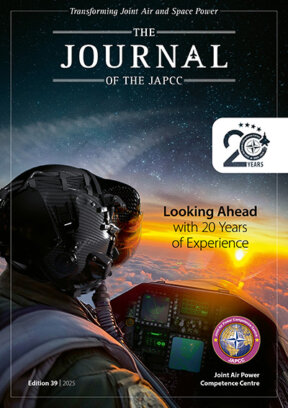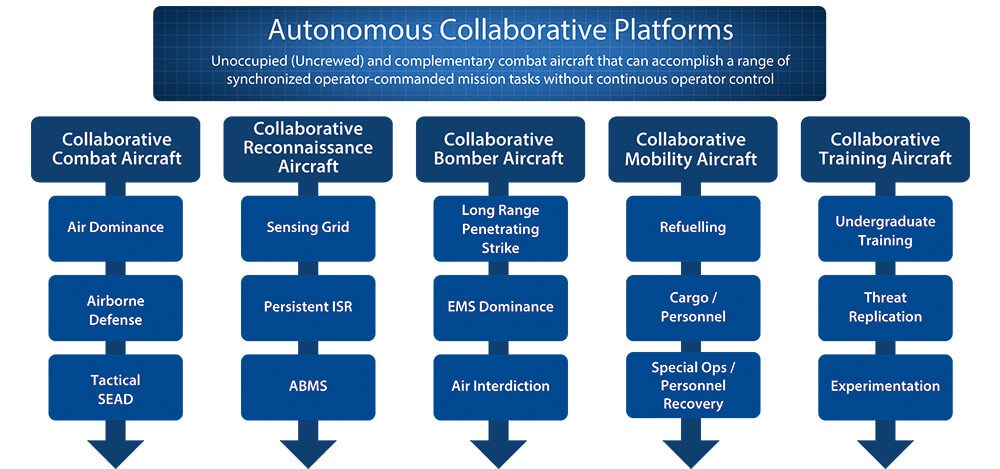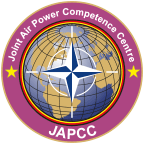Introduction
In May 2024, the Secretary of the US Air Force, Frank Kendall, took a groundbreaking flight aboard a modified F-16 (X-62A VISTA), while it was controlled exclusively by autonomous, artificial intelligence (AI)-enabled software. As the Secretary sat in the front seat, the AI-controlled aircraft flew several tactical engagements against a piloted fighter, performing complex calculations to safely and efficiently fly a close-range dogfight against its manned opponent.1
Secretary Kendall’s flight was an important milestone for an ongoing human-machine collaboration programme called Air Combat Evolution (ACE), which is led by the Defense Advanced Research Projects Agency (DARPA).2 However, it was more than just a technology demonstration. Instead, it symbolized a much broader paradigm shift in air combat worldwide: the emergence of a new class of autonomous aircraft capable of receiving and executing human commands without continuous operator control. These aircraft are known as Autonomous Collaborative Platforms (ACP).3 The purpose of this article is to describe these systems, highlight their ongoing development, and underscore the work that must be done to prepare for the arrival of this emerging technology.
While often viewed in the narrower context of CCAs, ACPs might also accomplish diverse missions ranging from reconnaissance to training roles.
The term ACP refers to a new category of Unmanned Combat Air Vehicle (UCAV) which uses AI technology to translate human intent, ranging from specific commands to general objectives, into autonomous actions. The spectrum of autonomy can vary depending on the mission, and may range from a highly collaborative ‘loyal wingman’ working directly with another fighter, to a fully autonomous platform which receives infrequent mission updates from a human. Their diverse roles span five categories of missions, including Collaborative Combat Aircraft (CCA), Collaborative Reconnaissance Aircraft (CRA), Collaborative Bomber Aircraft (CBA), Collaborative Mobility Aircraft (CMA) and Collaborative Training Aircraft (CTA). The most well-known category of ACPs are CCAs, which are designed to fight in the vicinity of piloted fighters to enhance lethality and survivability on high-risk missions.4
Worldwide ACP development is expected to grow rapidly this year, as nations and industry partners begin teaming up to build initial ACP prototypes. Among European NATO members, two nascent initiatives are gathering momentum: the first involving the United Kingdom, Italy, and Japan, with partners BAE, Leonardo, and Mitsubishi; and the second, involving France, Germany, and Spain, with partners Airbus, Dassault, and Indra Sistemas.5,6 In the United States, the US Air Force (USAF) is already quite far along in its ACP programmes, and is moving quickly to procure up to 1000 CCAs as a crucial pillar of what it calls its Next Generation Air Dominance (NGAD) family of systems. In 2024, the USAF awarded contracts to Anduril and General Atomics to compete in Increment I prototype testing, and it plans to spend $9 billion on future ACP designs by 2029, with a goal of achieving initial operational capability (IOC) by 2030.7 While the above-mentioned programmes are the most well-known, several other developments are also taking place in Sweden, Türkiye, South Korea, Japan, Australia, Russia, and China.8
ACPs: Pacific-Specific?
The rapid technological advancements and diverse applications of ACPs suggest that these platforms will play a transformative role in next-generation air power. This belief is quite strong within military and aerospace communities, where analyses conducted by the US, Australia, and the UK suggest that ACPs will address several challenges in the Indo-Pacific region, including the vast geography, sophisticated anti-access/area-denial (A2/AD) environment, advanced threats, and unfavourable force ratios expected in that theatre.9 Furthermore, a recent CCA study from the Mitchell Institute for Aerospace Studies took the research further. By conducting wargames and tabletop exercises, they helped postulate the specific types and quantities of CCAs needed in an Indo-Pacific conflict.10 While the study focused primarily on combat use cases, its findings emphasize the broad operational potential of ACPs in the Indo-Pacific, and highlight the importance of allied cooperation in tailoring these systems to regional needs.
Although much of the latest research is China-focused, it is essential to recognize that ACPs originated as a response to challenges posed by both China and Russia. Their development gained momentum during the creation of the US’s ‘Third Offset’ strategy, an initiative developed from 2014 to 2018 to counter the rapid military advancements of pacing competitors by leveraging advancements in AI, human-machine teaming, and drone warfare.11 Within this context, the strategy envisioned ACPs as a means to maintain a competitive edge in both the Indo-Pacific and European theatres, and their diverse capabilities can be tailored to the needs of each region.
Missing Pieces
While the Indo-Pacific has received significant analytical attention, the European theatre’s ACP potential remains underexplored. If NATO intends to leverage this technology for deterrence and defence, it must make a deliberate effort to bridge several gaps. This section highlights the work that must be done by NATO members, industry partners, warfare centres, and academic institutions to address the following missing pieces:
- NATO-Centric Operational Analyses: Analyse NATO’s existing and future capability gaps to determine whether and how ACPs might contribute to future force designs.
- Design Integration: Align research, development, testing, fielding, and training efforts across NATO members to ensure interoperability.
- Streamline Capability Development: Expedite design requirements and procurement processes for ACPs and other emerging technologies.
- Ethical and Legal Foundations: Establish robust, quantifiable frameworks to build confidence in autonomous and collaborative systems in warfare.
Proactively addressing these missing pieces will ensure that future designs will meet NATO’s defence and deterrence requirements, operate cohesively, arrive on time, and perform within appropriate legal and ethical boundaries.
Piece 1: NATO-Centric Operational Analyses
To harness the potential of ACPs, NATO must conduct operational analyses tailored to its unique strategic environment. These studies will enable a deeper understanding of how ACPs might enhance NATO’s current force designs, particularly in areas where traditional platforms face significant capacity or capability gaps. Since the USA has already conducted extensive studies on the Indo-Pacific, NATO should prioritize the European theatre and its surrounding areas of responsibility (AORs), emphasizing the Baltic, Arctic, Mediterranean, North Africa, the Middle East, and the Red Sea. By exploring the use of ACPs in these diverse, operationally demanding areas, NATO can better define the requirements which most effectively address its security concerns.
The potential mission sets for ACPs are extensive. While typical concepts of operation tend to highlight the offensive potential of the CCA class of systems, the CRA class could prove indispensable for NATO by conducting reconnaissance in austere areas or within contested environments. For instance, given their ability to operate autonomously for extended periods, CRAs could conduct air, land, and maritime surveillance along NATO’s eastern flank, the Arctic, and the Red Sea. Similarly, during a high-threat conflict against a peer adversary, other CRA variants could perform risky reconnaissance missions inside A2/AD bubbles, providing real-time intelligence to find and fix dynamic targets. Upon target detection, the CRA would notify the pilot of a manned fighter, who could then send an updated mission task to a nearby CCA, perhaps directing it to attack or to conduct suppression of enemy air defence (SEAD) to support the fighter. Such employment concepts can reduce risks to manned platforms, cut kill chain timelines, and increase overall mission success rates.
To identify these and other practical use cases, NATO should employ various methodologies, including wargaming, simulations, and scenario-based modelling. Wargames, such as those conducted by the Mitchell Institute, have already demonstrated the value of CCAs in complex Indo-Pacific environments. NATO members can replicate and expand these studies by incorporating region-specific parameters, such as the A2/AD environments posed by Russia’s integrated air defence System (IADS) in Kaliningrad, the vast intelligence, surveillance, and reconnaissance (ISR) requirements of the Arctic and High North, and by examining other ACP variants in extended deterrence operations in the Middle East and beyond.
As part of the NATO-centric analyses, complementary studies should also explore other emerging, and potentially alternative, systems that are achieving IOC over the next decade, such as hypersonic weapons, one-way attack (OWA) drones, and improved cruise missiles. These analyses must be done simultaneously to help articulate the procurement trade-offs of each system. This effort must occur as soon as possible since the results will inform research and development (R&D) priorities and will influence upcoming budget cycles.
Piece 2: Design Integration
Next, while NATO members have the capability to create diverse ACP designs, proper integration must take place to maximize the interoperability of these assets across the Alliance. To achieve adequate integration, standardization, and interoperability between ACPs and manned fleets, NATO and its defence partners must proactively establish and share foundational architecture, including communication and network standards, technical and operational interoperability standards, and cross-servicing agreements.
The ongoing F-35 procurement among 14 NATO members provides an example of such coordination and interoperability. The programme unites diverse stakeholders and achieves multinational interoperability by establishing common security classifications, standardized technical agreements, and shared logistics infrastructure.12 Applying similar collaboration principles to ACPs will mitigate risks and enhance operational effectiveness.
Currently, the highest priority task is to ensure that NATO uses a common communication architecture between surface-based C2 nodes, fourth- and fifth-generation aircraft, and ACPs. Doing so requires consensus across the Alliance, making this the highest priority for NATO’s future ACP interoperability.
Organizations such as the NATO Standardization Office (NSO), NATO’s Science and Technology Organization (STO), Allied Command Transformation (ACT), and the Joint Capability Group Unmanned Aircraft Systems (JCGUAS) play essential roles in fostering collaboration. Therefore, it is important for stakeholders to collaborate with these organizations to quickly accomplish ongoing interoperability initiatives, including the NSO’s Military Committee Joint Standardization Board (MCJSB), STO’s Applied Vehicle Technology (AVT) panel and the JCGUAS’ Autonomy Task Force.13
Piece 3: Streamlining Capability Development
Next, to keep pace with rapidly advancing technology, NATO must streamline the development and fielding of ACPs through stronger collaboration between members and defence industry partners. However, industry officials have highlighted two main obstacles: First, NATO’s planning process often lags behind real-world advancements by several years, and second, there is a need for NATO to support agile development and prototyping for ACPs and other emerging capabilities.14
One reason for these challenges is the complexity of aligning the national priorities and economic interests of 32 member states. The current method of defining requirements while retaining Alliance cohesion is the NATO Defence Planning Process (NDPP), which begins its next four-year cycle in 2026. While the NDPP is a useful methodology for long-term and steady-state requirements, unfortunately, its multi-year timeline means that NATO might finish defining its ACP requirements while other countries are already achieving IOC.15
Instead, NATO must create a more responsive process to advance new technologies from idea to prototype. One option is to broaden or refine the roles of currently existing entities, including the Defence Innovation Accelerator for the North Atlantic (DIANA) and ACT’s NATO Innovation Hub. DIANA currently focuses on long-term innovation, harnessing academia and think tanks to generate ideas and to promote future capabilities on 10- to 20-year timelines.16 In contrast, ACT plays an important role in promoting near-term innovation, and its Innovation Hub is a useful forum for collaboration on projects at a higher technology readiness level (TRL) than DIANA.17
However, neither of these organizations has a mandate to guide a complete innovation cycle from start to finish. As a solution, ACT or DIANA could create new Rapid Capability Accelerator (RCA) teams authorized and funded to design, prototype, and experiment with a specific emerging technology on an aggressive timeline. Each 10- to 15-member RCA team would comprise military operators, defence procurement experts, industry experts, and technical specialists dedicated to converting a new technology into a viable prototype. Such teams could also collaborate with both NATO and non-NATO countries to fast-track operational requirements on timescales measured in one to two years rather than decades.
Changes to the development process must be implemented quickly, as NATO risks falling behind in emerging defence capabilities. By developing a faster, more proactive approach to R&D projects, NATO can more effectively define and communicate its emerging requirements and enable industry to move quickly toward technical solutions.
Piece 4: Ethical and Legal Foundations
A recent Royal Air Force strategy document concludes that ‘the uncrewed systems world is rapidly and inexorably advancing towards the use of Autonomous Collaborative Platforms.’18 This trend appears indisputable, yet it raises important ethical and legal considerations which NATO must address. Currently, most literature focuses on the human-machine teaming and semi-autonomous capabilities of these platforms, wherein an ACP makes non-lethal mission decisions while a ‘human on the loop’ (HOTL, or HOnL) provides authority for any attacks. However, the next step is clear: NATO must prepare for the arrival of ‘human out of the loop’ (HOOTL, or HOutL) warfare.
Luckily, NATO has proactively addressed the complexities of lethal autonomy in warfare. The December 2023 ‘NATO Autonomy Guidelines for Practitioners’ provides a common lexicon and a practical list of considerations as platforms increase autonomy levels.19 Additionally, JAPCC’s White Paper, ‘Future Unmanned System Technologies – Legal and Ethical Implications of Increasing Automation’, also addresses practical concerns such as specific legal requirements applicable to Law of Armed Conflict (LOAC) adherence.20 The JCGUAS Autonomy Task Force also meets regularly to establish a transparent, ethical framework for the technology.
The next step for NATO and the defence industry is to instil trust and confidence in AI’s ethical and legal adherence, by converting qualitative legal and moral constraints into specific, measurable AI parameters. A new initiative at DARPA, called ASIMOV, addresses this challenge directly, explaining, ‘The rapid development and impending ubiquity of autonomy and AI technologies across both civilian and military applications require a robust and quantitative framework to measure and evaluate not only the technical but, perhaps more importantly, the ethical ability of autonomous systems to follow human expectations.’21
At first glance, quantifying ethical and legal constraints seems impossible. However, NATO rules of engagement (ROE) already include quantifiable parameters which are applicable to AI-enabled ACPs, including geographic safe zones, sensitive target lists, safe-distance charts, and collateral damage estimates (CDE). Such codified rules are prerequisites for testing and evaluation, which is an essential step to building confidence and trust in an autonomous system.22
Establishing strong ethical and legal foundations is crucial for the successful integration of ACPs into NATO’s defence strategy. By proactively addressing these issues, NATO can ensure its use of autonomous systems aligns with its values.
Conclusion
Upon landing from his F-16 flight, Secretary Kendall stated, ‘In the not-too-distant future, there will be two types of Air Forces – those who incorporate this technology into their aircraft and those who do not and fall victim to those who do.’23 The rapid development of ACPs presents tremendous opportunities and complex challenges for NATO. To succeed, NATO members, industry leaders, and military institutions must proactively and quickly prepare for their arrival. Achieving this will require a NATO-focused approach which addresses current operational gaps, interoperability standards, procurement processes, and legal-ethical foundations. By tackling these shortcomings, NATO will ensure that all pieces are in place to build a cohesive ACP strategy.












